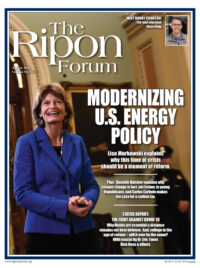
When the coronavirus pandemic first hit the United States in March of this year, I recommended that Congress immediately suspend the payroll tax for both employers and employees through the rest of the year. My reasoning was simple. A payroll tax suspension could be implemented immediately, would reduce the cost of keeping workers on staff, and put more money in the hands of workers.
The U.S. was facing an unprecedented economic and health threat. We knew little about how the threat would unfold or how deeply the economy would be impacted. What was clear, however, is that many businesses and households were going to take an immediate hit to their liquidity.
In particular, businesses would have a hard time holding on to their employees as the virus induced lockdowns across the country. I was also skeptical about how quickly and effectively the Small Business Administration would be able to implement a new nationwide system of lending.
Facing an uncertain threat, with untested tools, a payroll tax suspension would have served as a useful backstop against unforeseen events and the difficulties in getting what became the Payroll Protection Program started.
Facing an uncertain threat, with untested tools, a payroll tax suspension would have served as a useful backstop against unforeseen events.
Now, however, several months into the crisis, the case for a payroll tax cut is far more nuanced. One of its major selling points – that it quickly injected enormous amounts of liquidity into the economy – has turned into a drawback as many lawmakers are looking to limit the total size of future relief bills.
There are three basic channels through which a payroll tax suspension could boost the economy. The first is the classic supply-side effect. When you tax something you get less of it. Economists agree that the burden of both the employer and employee sides of the payroll tax fall on labor.
Cutting the payroll tax should reduce the burden on labor and thereby increase total employment. This is basically the analysis that Casey Mulligan — an economics professor at the University of Chicago who served as chief economist for the Council of Economic Advisers from September 2018 to August 2019 — uses when he estimates that suspending the payroll tax for six months would create 2.7 million new jobs.
This type of supply-side analysis starts by looking at what would happen to the economy in the long-run after all markets have full adjusted. As Mulligan admits, it is very difficult to estimate how quickly an economy will move towards its long-run equilibrium, especially in the midst of a pandemic.
Mulligan deals with this uncertainty by first estimating that a permanent payroll tax elimination would generate 10.7 million jobs and then assuming the economy gets to about one-quarter of the long-run equilibrium within six months. Reasonable people can disagree about whether the economy could adjust that fast, but there are two immediate concerns with this analysis.
First, the same reasoning would suggest that the economy would shed 2.7 million jobs in the six months after the payroll tax suspension expired. Second, knowing that the expiration was coming, would employers be willing to create additional jobs that they knew were soon going away?
This type of analysis is best understood as estimating how much benefit the economy could see by the end of the year if Congress decided now to eliminate the payroll tax entirely. There is no doubt that permanently eliminating the payroll tax would have a profound impact on the job market. However, that’s a proposal much larger than anything that lawmakers have suggested they are willing to entertain.
Still, there are ways that even a temporary payroll tax suspension could affect the demand-side of the economy during a crisis. That brings us to the second channel — liquidity. The payroll tax injects money into the economy, which helps households increase savings and pay down debt without cutting back as sharply on consumer spending.
During times of uncertainty, households and businesses naturally become more risk-averse. Households try to improve their finances by increasing saving and reducing debt. To do this, however, they must decrease spending. That decline in spending then leads businesses, which are already more risk-averse because of the crisis, to reduce hiring.
A payroll tax suspension could increase the speed at which new matches between employers and employees are made.
That reduction in hiring in turn weakens the job markets and makes households more risk- averse. This can create a self-reinforcing cycle that turns a temporary economic shock into a prolonged recession. Cutting off this cycle can help mitigate the damage from the initial shock and jump-start growth.
That’s part of the logic behind simply sending cash rebate checks to families when the pandemic first struck. A payroll tax cut would have a similar effect, but would have the downside of excluding many people who have lost their jobs.
On the other hand, one might argue that Congress has been especially generous in its benefits for the unemployed and that targeting stimulus towards those with jobs would help mitigate that. It would also encourage businesses who were just on the cusp of hiring new workers to do so.
That brings us to the third channel — a payroll tax suspension, which could increase the speed at which new matches between employers and employees are made. One of the issues during a recession is that employees are reluctant to take a job at a wage rate that is below what they were making before.
Businesses, however, facing reduced sales and an uncertain market, are reluctant to hire workers at the same wage they were paying before the crisis started. This gap could be partially closed if the workers wages could be temporarily boosted while the cost of hiring new employees is temporarily subsidized.
As the economy improved, both the wage boost and the hiring subsidy could be removed. This is precisely how a temporary payroll tax cut could work. The problem, as with all such fine tuning measures, is timing. To be maximally effective, the suspension would have to provide the right-sized boost to the right workers and employers at the right time.
If it were removed too soon, it would provide a new shock to the economy. If it were held too long, it would create enormous revenue loss with little long-term economic benefit. It has to arrive just in time to fill the temporary gap between the wages that employers are willing to offer and employees are willing to accept.
For these reasons, I favor policy that permanently increases investment in the economy. It has the same sort of jump-starting effect, but without the need to get the timing right. Moreover, it provides much greater bang-for-the-buck in terms of long-term growth. A permanent increase in cost recovery for investment would cost as much over the ten-year budget cycle as a temporary cut in the payroll tax. Yet the growth effects would persist long after the crisis is over.
Karl Smith is the Vice President for Federal Tax and Economic Policy at the Tax Foundation.




